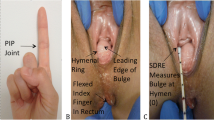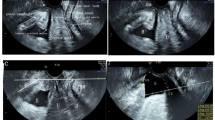Abstract
Introduction and hypothesis
The primary aim of this study was to evaluate the inter-examiner agreement of a previously described simplified pelvic organ prolapse quantification (S-POP) system in a multicenter, prospective, randomized, blinded fashion. Pelvic organ prolapse quantification (POPQ) system’s use in daily practice is hampered due to perceived complexity and difficulty of use. The S-POP was introduced in order to make the POPQ user-friendly and increase its usage (Swift et al. in Int Urogynecol J 17(6):615–620, 2006).
Methods
Five hundred eleven subjects underwent two separate pelvic exams in random order by two blinded examiners employing the S-POP at 12 centers around the world. Data were compared using weighted kappa statistics.
Results
The weighted kappa statistics for the inter-examiner reliability of the S-POP were 0.87 for the overall stage, 0.89 and 0.81 for the anterior and posterior vaginal walls, 0.82 for the apex/cuff 0.89, and 0.84 for the cervix and vaginal fornix, respectively.
Conclusion
There is an almost perfect inter-examiner agreement of the S-POP system for the overall stage and each point within the system.
Similar content being viewed by others
References
Friedman EA, Little WA (1961) The conflict of nomenclature for descensus uteri. Am J Obstet Gynecol 81:817–820
Porges RF (1963) A practical system of diagnosis and classification of pelvic relaxations. Surg Gynecol Obstet 117:761–773
Baden WF, Walker TA (1972) Genesis of the vaginal profile: a correlated classification of pelvic relaxation. Clin Obstet Gynecol 15:1048–1054
Brubaker L, Norton P (1996) Current clinical nomenclature for description of pelvic organ prolapse. J Pelvic Surg 2:257–259
Bump RC, Mattiasson A, Bo K, Brubaker LP, DeLancy JOL, Klarskov P et al (1996) The standardization of the terminology of female pelvic organ prolapse and pelvic floor dysfunction. Am J Obstet Gynecol 175:10–17
Hall AF, Theofrastous JP, Cundiff GW et al (1996) Interobserver and intraobserver reliability of the proposed International Continence Society, Society of Gynecologic Surgeons, and American Urogynecologic Society pelvic organ prolapse classification system. Am J Obstet Gynecol 175:1467
Kobak WH, Rosenberger K, Walters MD (1996) Interobserver variation in the assessment of pelvic organ prolapse. Int Urogynecol J 7:121–124
Muir TW, Stepp KJ, Barber MD (2003) Adoption of the pelvic organ prolapse quantification system in peer-reviewed literature. Am J Obstet Gynecol 189:1632
Visco AG, Wei JT, McClure LA, Handa VL, Nygaard IE (2003) Effects of examination technique modifications on pelvic organ prolapse quantification (POP-Q) results. Int Urogynecol J 14:136–140
Treszezamsky AD, Rascoff L, Shahryarinejad A, Vardy MD (2010) Use of pelvic organ prolapse staging systems in published articles of selected specialized journals. Int Urogyn J 21:359–363. doi:10.1007/s00192-009-1044-1
Auwad W, Freeman RM, Swift S (2004) Is the pelvic organ prolapse quantification system (POPQ) being used? A survey of members of the International Continence Society (ICS) and the American Urogynecologic Society (AUGS). Int Urogynecol J Pelvic Floor Dysfunct 15:324
Davila GW, Goniem GM, Kapoor DS, Contreras-Ortiz O (2002) Pelvic floor dysfunction management practice pattern: a survey of members of the International Urogynecological Association. Int Urogynecol J Pelvic Floor Dysfunct 13(5):319–325
Swift SE, Morris S, McKinnie V (2006) Validation of a simplified technique for using the POP-Q pelvic organ prolapse quantification system. Int Urogynecol J 17(6):615–620
Landis JR, Koch GG (1977) The measurement of observer agreement for catagorical data. Biometrics 33:159–174
Swift SE, Woodman P, O’Boyle A, Kahn M, Valley M, Bland D, Wang W, Wang W, Schaffer J (2005) Pelvic Organ Support Study (POSST); the distribution, clinical definition and epidemiology of pelvic organ support defects. Am J Obstet Gynecol 192:795–806
Swift SE (2000) The distribution of pelvic organ support in a population of female subjects seen for routine gynecologic healthcare. Am J Obstet Gynecol 183:277–285
Swift SE, Tate SB, Nichols J (2003) Correlation of symptomology with degree of pelvic organ support in a general population of women: what is pelvic organ prolapse? Am J Obstet Gynecol 189:372–9
Conflicts of interest
None.
Author information
Authors and Affiliations
Corresponding author
Appendix 1: list of participating centers
Appendix 1: list of participating centers
-
(1)
Faculdade de Ciências Médicas da Santa Casa de São Paulo, Sao Paulo, SP, Brazil
-
(2)
Southport and Formby District Hospital, Southport, United Kingdom
-
(3)
Derriford Hospital, Derriford, Plymouth, United Kingdom
-
(4)
City Hospital, Birmingham, United Kingdom
-
(5)
Faculty of Medicine, Ain Shams University, Cairo, Egypt
-
(6)
General Faculty Hospital of Charles University, Prague, Czech Republic
-
(7)
Miller School of Medicine, University of Miami, Miami, FL, USA
-
(8)
Rio de Janeiro Federal University, Rio de Janeiro, Brazil
-
(9)
Geisinger Medical Center, Danville, PA, USA
-
(10)
Warwick Hospital, Warwick, United Kingdom
-
(11)
Medical University of Lodz, Lodz, Poland
-
(12)
Faculty Hospital Bulkova of Charles University, Prague, Czech Republic
Rights and permissions
About this article
Cite this article
Parekh, M., Swift, S., Lemos, N. et al. Multicenter inter-examiner agreement trial for the validation of simplified POPQ system. Int Urogynecol J 22, 645–650 (2011). https://doi.org/10.1007/s00192-011-1395-2
Received:
Accepted:
Published:
Issue Date:
DOI: https://doi.org/10.1007/s00192-011-1395-2




